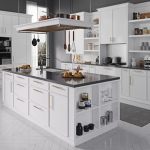In recent years, open-concept living spaces have gained immense popularity for their seamless flow, spaciousness, and ability to bring people together. When designing an open-concept living space, it is crucial to consider how to integrate the kitchen area with the rest of the living area. This article delves into the art of designing such living spaces by focusing on the integration of kitchen cabinets and furniture. By blending functionality and aesthetics, homeowners can create a harmonious and inviting space that connects the kitchen and the surrounding living area.
Understanding the Open Concept Living Space
An open-concept living space refers to a design concept that combines multiple functional areas, such as the kitchen, dining area, and living room, into a single, uninterrupted space. It eliminates physical barriers like walls and partitions, creating a sense of openness and connectivity. The benefits of an open-concept living space are manifold. Firstly, it promotes social interaction and facilitates seamless communication among family members and guests. It allows for a more spacious and airy ambiance, maximizing natural light and creating a sense of expansiveness.
Additionally, such a living space enhances flexibility in furniture arrangement, enabling homeowners to adapt the layout to their changing needs. When designing such a space, key considerations include maintaining a cohesive design theme, optimizing traffic flow, ensuring proper acoustics, and striking a balance between shared and private spaces. Careful planning and thoughtful execution can result in a dynamic and inviting open-concept living space that enhances the overall functionality and aesthetics of a home.
Integrating Kitchen Cabinets
Customizing kitchen cabinets allows for a cohesive and harmonious look. By selecting materials, finishes, and hardware that align with the overall aesthetic, the cabinets can become an integral part of the space. Furthermore, incorporating multi-functional features, such as built-in seating, breakfast bars, or island extensions, adds versatility and functionality to the kitchen area. This not only enhances the efficiency of the space but also creates a seamless transition between the kitchen and living area, encouraging social interaction and engagement.
Balancing the desire for storage with the need for open shelving or glass-front cabinets for display purposes is also important. Open shelves or glass-front cabinets can showcase decorative items or cherished kitchenware, adding visual interest and personalization to the space.
Selecting Furniture for the Living Area
When designing an open-concept living space, it is essential to choose furniture pieces that complement the style and scale of the kitchen cabinets, ensuring seamless integration between the two spaces. By selecting furniture that shares similar design elements, such as matching materials or complementary colors, a cohesive look is achieved.
Additionally, providing adequate seating options is essential for both the kitchen and living areas, as it encourages social interaction and accommodates gatherings. Incorporating versatile furniture pieces further enhances the functionality of the space, allowing for an easy transition between the kitchen and living area. For example, movable kitchen islands or dining tables with extendable leaves can serve as additional workspace or dining areas, depending on the need. By carefully selecting furniture pieces from decoelements.fr that harmonize with the kitchen cabinets, ensuring ample seating, and incorporating versatile options, homeowners can create a unified and functional living area in their open-concept space.
Cohesive Design Elements
Creating a cohesive design theme is essential when integrating the kitchen and living area in an open-concept living space. By establishing a common thread that runs through both areas, a sense of unity and harmony is achieved. This can be accomplished by selecting complementary colors, materials, and finishes for the kitchen cabinets and furniture. Harmonizing the overall style and mood further enhances the seamless transition between the two spaces.
For instance, if the kitchen cabinets feature a contemporary design with sleek lines and a minimalist aesthetic, choosing furniture that reflects similar characteristics will help maintain a cohesive look. Similarly, coordinating the color palette and using complementary materials, such as matching wood finishes or coordinating metal accents, will ensure a cohesive and visually appealing integration.
Space Planning and Layout
Optimizing the layout is essential to ensure a functional and efficient flow between these spaces. Careful consideration should be given to the placement of kitchen cabinets and furniture to allow for easy movement and accessibility. Balancing the need for storage and display is another key consideration.
While kitchen cabinets provide essential storage, it is important to strike a balance that allows for open-sight lines and unobstructed views. This creates a sense of spaciousness and promotes a cohesive atmosphere. Additionally, kitchen cabinets and furniture can be strategically used to define zones within the open concept space, creating designated areas for cooking, dining, and relaxation.
Lighting and Ambiance
A cohesive lighting scheme that encompasses both the kitchen and living areas is essential. This can be achieved by carefully selecting lighting fixtures that complement each other in terms of style and finish. Task lighting is important for the kitchen workspace, ensuring ample illumination for cooking and food preparation, through under-cabinet lighting, pendant lights, or track lighting.
In the living area, ambient lighting sets the mood and creates a warm and inviting atmosphere. This can be achieved through the use of recessed lighting, floor lamps, or chandeliers. Furthermore, lighting fixtures can also be utilized as design elements to enhance the overall aesthetic of the space. Choosing fixtures that align with the design theme, such as sleek and modern fixtures for a contemporary space or vintage-inspired fixtures for a rustic ambiance, can elevate the overall visual appeal.
Creating a Sense of Flow and Connection
Visual cues play a vital role in achieving this cohesion. By incorporating consistent flooring throughout the space, whether it’s hardwood, tile, or laminate, a seamless transition is created, visually connecting the kitchen and living areas. Similarly, selecting complementary color palettes and coordinating textures further enhances the sense of unity and flow.
Additionally, the placement of kitchen cabinets and furniture should be carefully considered to facilitate movement and interaction. Strategic positioning can create natural pathways and open sightlines, allowing for easy navigation and encouraging social engagement. Furthermore, incorporating open shelves or glass doors can visually connect the kitchen and living areas. This allows for glimpses of the kitchen from the living area and vice versa, fostering a sense of connection and continuity.
Conclusion
Integrating kitchen cabinets and furniture is an important part of designing an open-concept living space. By selecting pieces that are similar in style and color, homeowners can create a cohesive and unified look for the home. Additionally, it is significant to consider the size and function of the pieces, as well as the overall design of the room. With the right kitchen cabinets and furniture, homeowners can create a modern and inviting space that is sure to impress their guests.





